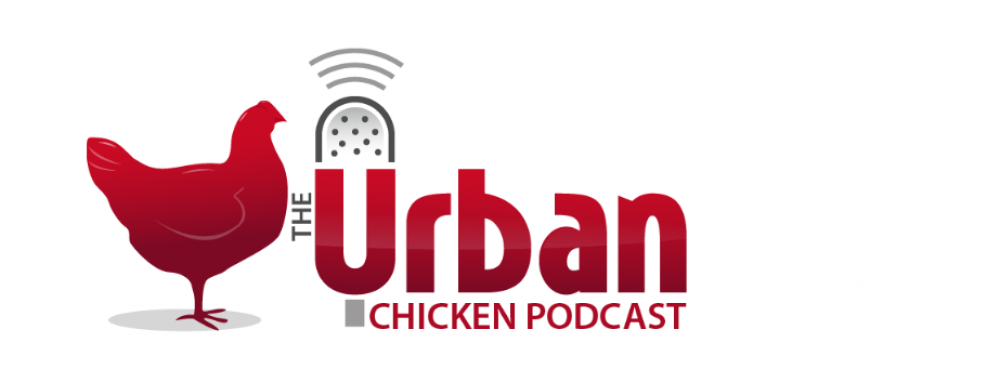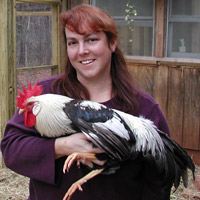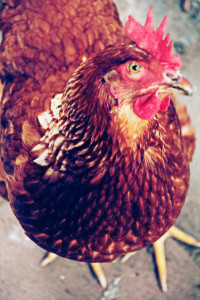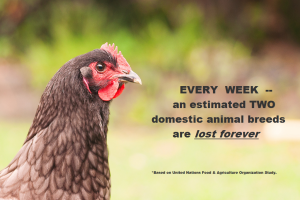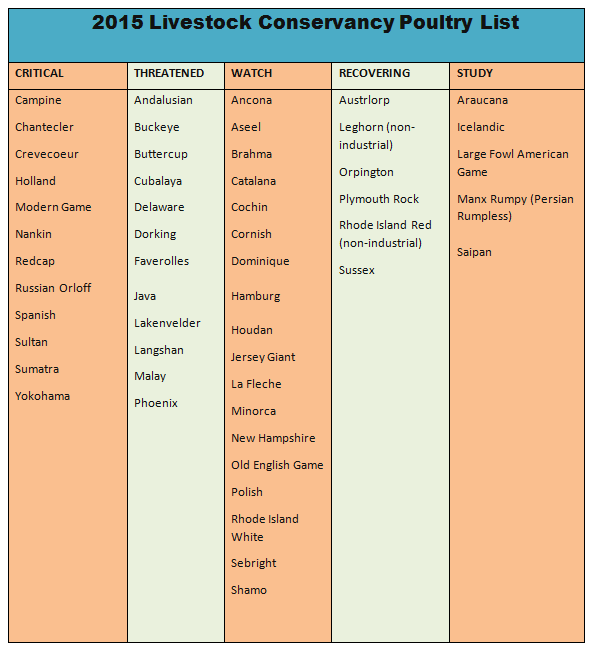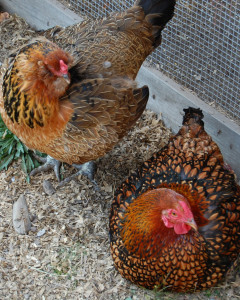How many grizzly bears are in the United States? 1,800. How many grey wolves in America? 5,443 in the lower 48 states (there is an estimated additional 7,700 -11,000 in Alaska.) How many Redcap breed chickens in the States? Fewer than 500 (and fewer than 2,000 in the world.)
There are currently twelve different chicken breeds listed as “critically endangered” and an additional twelve breeds on the “threatened” list (fewer than 1,000 in the U.S. and 5,000 worldwide) according to the Livestock Conservancy. While the WWF is fighting to protect pandas and rhinos, the Livestock Conservancy is tirelessly working to protect threatened heritage horse, cattle, donkey, goats, sheep, pigs, chickens, ducks, geese, turkeys and rabbit populations.
Jeannette Beranger, the Research and Technical Programs Manager for the Livestock Conservancy joins me on the Urban Chicken Podcast to discuss the mission of this organization, some of the projects the Conservancy is currently involved in and how backyard hobbyist chicken keepers (like you and me) can help save some rare and special breeds from becoming extinct from our own backyards.
Jeannette has over 25 years of experience working with animals first as a veterinary technician and then later for several years with the Roger Williams zoo, where she eventually became the head zookeeper. For the past few years, Jeannette has worked with the Livestock Conservancy researching, educating, networking and implementing various programs and efforts to save endangered heritage livestock breeds with the Conservancy. She has a depth of knowledge on animals and particularly heritage breed livestock to share on today’s show.
Agricultural systems in the United States (as well as worldwide) have increasingly
become very industrial since the 1950’s “green revolution.” Consequently, industrialized farms utilizing hybridized breeds have replaced the traditional and varied livestock once found in backyards and on small family farms across this nation. Though these “improved” hybrid poultry breeds (e.g. sex-links, ISA Brown, ISA Warrens, Cornish-Crosses, Leghorns, etc.) may grow faster or lay more eggs, they are not necessarily the hardiest or most delicious breeds for the table.
The Livestock Conservancy is working to protect nearly 200 breeds of livestock and poultry from extinction. The organization seeks to save these rare breeds, not by trying to have them replace the hybrid breeds used on large-scale, commercial farms, but rather as complimentary alternatives found on small-scale farms and private lands. The Livestock Conservancy works tirelessly to protect the future of agriculture in the United States through safeguarding the genetically diverse bloodlines found in each of these endangered heritage breeds.
The Livestock Conservancy’s Mission in Action
A three prong approach is used by the Livestock Conservancy in its fight to save our heritage breeds: 1) Discover, 2) Secure, and 3) Sustain. Each of these conservation prongs is crucial to saving rare livestock breeds.
The discover prong means to actually find rare breeds. These rare breeds often have quietly survived for generations until they are found again. Historical research, DNA testing and physical examination and comparison are some of the techniques used in “discovering” rare breeds that need protection.
The second prong, secure, means to safeguard discovered rare breeds from further genetic erosion. This is accomplished mainly through encouraging breeders to save these breeds by continuing to raise and breed them. Conservation of genetically diverse bloodlines within these breeds is crucial as well to prevent inbreeding. Helping breeders to maintain several bloodlines secures these breeds for the future.
The last prong – sustain, is crucial for the continued success of a rare breed. In order to sustain a breed, efforts to grow interest and enthusiasm in the breed, practicing good animal husbandry and helping the breeders find markets for these animals are all necessary to prevent the breed from slipping back into peril of going extinct.
Discover, Secure and Sustain are the three steps that the Livestock Conservancy has used for more than 30 years to enact its mission to ensure the future of agriculture through genetic conservation and promotion of heritage breeds. This organization recognizes the inherent danger in commercial agriculture relying on a very limited genetic pool. Any significant disease or genetic defect in the world of industrial farming could topple that structure. Rare breeds are needed to be available to provide diverse genetic material if the worst should happen.
The Livestock Conservation Priority List & Criteria
The annual priority list of the endangered livestock breeds is based on current populations of that species. In order to get accurate numbers on the existing populations of poultry breeds, a census of hatcheries, major breeders, breed clubs, poultry associations, and Livestock Conservancy members is taken. Additionally the census survey is advertised in magazines to the public at large.
Only breeding stock birds are counted in the poultry census. Consequently, if a person owns just one bird or a few hens with no intention of breeding them, these birds will not be counted in the census. Birds which will not be bred provide no genetic contribution to future generations and are irrelevant to such a census.
There are five levels of priority in breed conservation: 1) critical, 2) threatened, 3) watch, 4) recovering, and 5) study. In order to be place on any of these conservation priority lists, the breed in question must first satisfy certain parameters.
All breeds on each of the five conservation lists must:
- a true genetic breed (i.e. when mated together, a true breed type is reproduced);
- the breed has an established and continuous breeding population in the United States since 1925 (or if imported/developed since 1925);
- the foundation stock is no longer available:
- there are at least three (3) breeding lines in the United States;
- there are at least twenty (20) breeding females in the United States; and
- Must be contributing to the breed’s survival internationally.
In additional to all of these initial criteria, endangered breeds which end up on the Livestock Conservancy’s “Priority List” for protection must also meet some stringent census numerical parameters.
The direst of the Conservancy’s five categories for protection is the eponymously named “critical” category. Poultry breeds which are deemed “critical” have fewer than 500 breeding birds in the United States (and fewer than an estimated 1,000 birds worldwide) with five or fewer primary breeding flocks (i.e. flocks comprised of 50+ birds of that breed) in addition to meeting all of the above mentioned initial guidelines.
Breeds fall into the “threatened” category if there are fewer than 1,000 breeding birds in the United States (and fewer than 5,000 breeders globally) with seven or fewer primary breeding flocks. Breeds with fewer than 5,000 breeding birds in the U.S. (10,000 globally) with fewer than ten primary breeding flocks are on the “watch” list.
Breeds which were once listed in the “critical” or “threatened” categories, but have since increased there population numbers to exceed the watch list parameters, are still monitored under the “recovering” list. Finally, rare breeds which are of interest but lack genetic and/or historic documentation or lack general definition are often placed within the Conservancy’s “study” category for closer examination and consideration.
There are currently over twenty chicken breeds alone on the “critical” and “threatened” 2015 conservation priority list. Below is the entire 2015 chicken priority list published by the Livestock Conservancy.
History of the Livestock Conservancy
The Livestock Conservancy was founded in 1977 by a group of farmers, environmentalists, historians and scientists who recognized the drastic genetic erosion of livestock in America and international and shared a concern for the fate of America’s heritage livestock breeds. The organization began with 58 due-paying members and the goal to conduct research on breed populations, education the public and provide technical support and advice to farmers and livestock breeders.
A decade later the Livestock Conservancy was a registered non-profit, had 800 members and was deeply busy working to save Santa Cruz sheep, San Clemente goats and Randall cattle in additional to several other breeds. In 1987, the Livestock Conservancy became the first conservation organization to add poultry to its endangered breeds list and established a semen bank of rare breeds.
In the 1990s, the Livestock Conservancy continued to significantly grow in membership and expand the breadth of its work, including the publication of several books on heritage breed conservancy. During this period, the organization was instrumental in helping to found the international livestock conservation group called, Rare Breeds International. In 1997, the group’s census of heritage turkey populations in America found only 1,335 breeding birds.
Throughout the 2000s, the Livestock Conservancy continued to blaze new trails in rare
breed conservation. The organization is credited with coining and defining the term “heritage chicken” and began to promote these rare breeds in the marketplace. The organization founded the first annual National Heritage Breeds Day this past May 23rd.
Through the past four decades this organization has worked with unflagging dedication to discover, secure and sustain endangered heritage breeds of livestock. As a result, the Livestock Conservancy today is the largest, non-profit organization in the United States working to protect and preserve rare and genetically diverse livestock breeds.
Join and/or Donate to the Livestock Conservancy
The Livestock Conservancy is able to pursue its mission (safeguarding the future of agriculture through conserving heritage livestock breeds for future generations) through the participation of everyday livestock keepers such as you. Even backyard hobbyists can serve a critical role in the preservation of heritage breeds by raising endangered breed hens – thereby providing a market for potential breeders/hatcheries for these birds. Join the Livestock Conservancy HERE.
If you are unable to join the Livestock Conservancy’s mission through direct participation, consider donating to their cause. This group is doing magnificent work protecting breeds that would likely be extinct in the next few decades without their efforts. That is a cause worthy of support. You can donate to the Conservancy through this LINK.
CHICKEN NEWS:
MAIN SEGMENT:
- Livestock Conservancy – website for the organization HOMEPAGE
- Jeannette Beranger’s Book – An Introduction to Heritage Breeds: Saving and Raising Rare-Breed Livestock and Poultry
- Livestock Conservancy – Conservation Priority Poultry Breeds 2015 CHART
- Mother Earth News Fair – See Jeannette Speak Live about Chickens FAIRS LINK
- Livestock Conservancy – National Heritage Breed Day (and week!) Info LINK
- Facebook – The Livestock Conservancy’s Facebook PAGE
- Twitter – The Livestock Conservancy’s Twitter FEED
- Mother Earth News – Preserve Endangered Breeds w/ Heritage Chicken ARTICLE
- Mother Earth News – Enjoy Heritage Chickens ARTICLE
- Backyard Chickens – Meet the Chooks: Critically Endangered Chickens ARTICLE
- US Fish & Wildlife – Gray Wolf: Current Populations in United States CHARTS
- Defenders of Wildlife – Grizzly Bear Fact Sheets CHART/STATS
- Down the Lane – Battery Hens Breed Information FORUM THREAD
SALLY’S SIDENOTES:
- Support the Urban Chicken Podcast by shopping Amazon starting here: Amazon
- If Amazon is not your thing – you could also support the show HERE
Podcast: Play in new window | Download | Embed
Subscribe: Apple Podcasts | RSS
